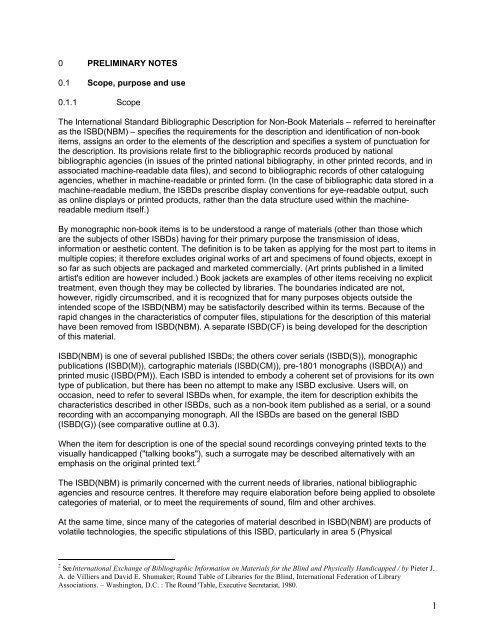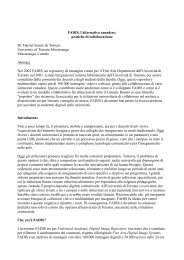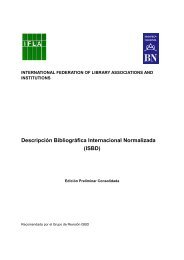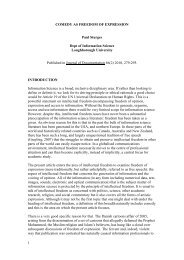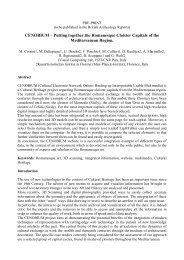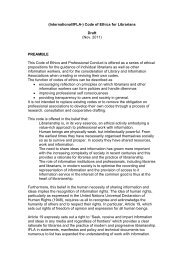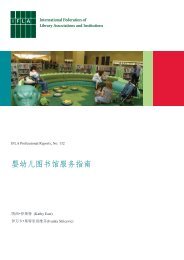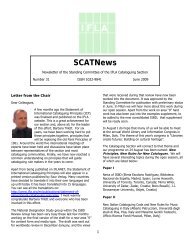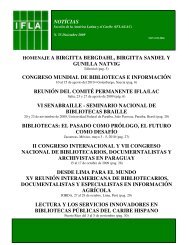ISBD(NBM) - IFLA
ISBD(NBM) - IFLA
ISBD(NBM) - IFLA
Create successful ePaper yourself
Turn your PDF publications into a flip-book with our unique Google optimized e-Paper software.
0 PRELIMINARY NOTES<br />
0.1 Scope, purpose and use<br />
0.1.1 Scope<br />
The International Standard Bibliographic Description for Non-Book Materials – referred to hereinafter<br />
as the <strong>ISBD</strong>(<strong>NBM</strong>) – specifies the requirements for the description and identification of non-book<br />
items, assigns an order to the elements of the description and specifies a system of punctuation for<br />
the description. Its provisions relate first to the bibliographic records produced by national<br />
bibliographic agencies (in issues of the printed national bibliography, in other printed records, and in<br />
associated machine-readable data files), and second to bibliographic records of other cataloguing<br />
agencies, whether in machine-readable or printed form. (In the case of bibliographic data stored in a<br />
machine-readable medium, the <strong>ISBD</strong>s prescribe display conventions for eye-readable output, such<br />
as online displays or printed products, rather than the data structure used within the machinereadable<br />
medium itself.)<br />
By monographic non-book items is to be understood a range of materials (other than those which<br />
are the subjects of other <strong>ISBD</strong>s) having for their primary purpose the transmission of ideas,<br />
information or aesthetic content. The definition is to be taken as applying for the most part to items in<br />
multiple copies; it therefore excludes original works of art and specimens of found objects, except in<br />
so far as such objects are packaged and marketed commercially. (Art prints published in a limited<br />
artist's edition are however included.) Book jackets are examples of other items receiving no explicit<br />
treatment, even though they may be collected by libraries. The boundaries indicated are not,<br />
however, rigidly circumscribed, and it is recognized that for many purposes objects outside the<br />
intended scope of the <strong>ISBD</strong>(<strong>NBM</strong>) may be satisfactorily described within its terms. Because of the<br />
rapid changes in the characteristics of computer files, stipulations for the description of this material<br />
have been removed from <strong>ISBD</strong>(<strong>NBM</strong>). A separate <strong>ISBD</strong>(CF) is being developed for the description<br />
of this material.<br />
<strong>ISBD</strong>(<strong>NBM</strong>) is one of several published <strong>ISBD</strong>s; the others cover serials (<strong>ISBD</strong>(S)), monographic<br />
publications (<strong>ISBD</strong>(M)), cartographic materials (<strong>ISBD</strong>(CM)), pre-1801 monographs (<strong>ISBD</strong>(A)) and<br />
printed music (<strong>ISBD</strong>(PM)). Each <strong>ISBD</strong> is intended to embody a coherent set of provisions for its own<br />
type of publication, but there has been no attempt to make any <strong>ISBD</strong> exclusive. Users will, on<br />
occasion, need to refer to several <strong>ISBD</strong>s when, for example, the item for description exhibits the<br />
characteristics described in other <strong>ISBD</strong>s, such as a non-book item published as a serial, or a sound<br />
recording with an accompanying monograph. All the <strong>ISBD</strong>s are based on the general <strong>ISBD</strong><br />
(<strong>ISBD</strong>(G)) (see comparative outline at 0.3).<br />
When the item for description is one of the special sound recordings conveying printed texts to the<br />
visually handicapped ("talking books"), such a surrogate may be described alternatively with an<br />
emphasis on the original printed text. 2<br />
The <strong>ISBD</strong>(<strong>NBM</strong>) is primarily concerned with the current needs of libraries, national bibliographic<br />
agencies and resource centres. It therefore may require elaboration before being applied to obsolete<br />
categories of material, or to meet the requirements of sound, film and other archives.<br />
At the same time, since many of the categories of material described in <strong>ISBD</strong>(<strong>NBM</strong>) are products of<br />
volatile technologies, the specific stipulations of this <strong>ISBD</strong>, particularly in area 5 (Physical<br />
2 See International Exchange of Bibliographic Information on Materials for the Blind and Physically Handicapped / by Pieter J.<br />
A. de Villiers and David E. Shumaker; Round Table of Libraries for the Blind, International Federation of Library<br />
Associations. – Washington, D.C. : The Round 'Table, Executive Secretariat, 1980.<br />
1


